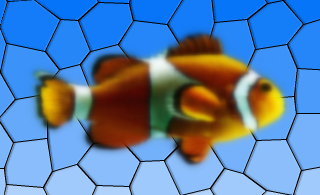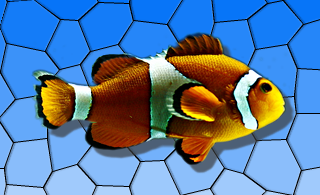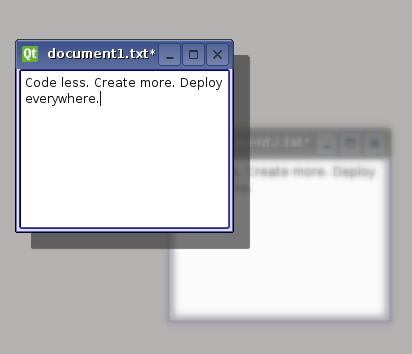QGraphicsEffect#
The QGraphicsEffect class is the base class for all graphics effects. More…
Inherited by: QGraphicsOpacityEffect, QGraphicsDropShadowEffect, QGraphicsColorizeEffect, QGraphicsBlurEffect
New in version 4.6.
Synopsis#
Properties#
enabled- Whether the effect is enabled or not
Functions#
def
boundingRect()def
drawSource(painter)def
isEnabled()def
sourceBoundingRect([system=Qt.LogicalCoordinates])def
sourceIsPixmap()def
sourcePixmap([system=Qt.LogicalCoordinates[, offset=None[, mode=QGraphicsEffect.PixmapPadMode.PadToEffectiveBoundingRect]]])def
updateBoundingRect()
Virtual functions#
def
boundingRectFor(sourceRect)def
draw(painter)def
sourceChanged(flags)
Slots#
def
setEnabled(enable)def
update()
Signals#
def
enabledChanged(enabled)
Note
This documentation may contain snippets that were automatically translated from C++ to Python. We always welcome contributions to the snippet translation. If you see an issue with the translation, you can also let us know by creating a ticket on https:/bugreports.qt.io/projects/PYSIDE
Detailed Description#
Effects alter the appearance of elements by hooking into the rendering pipeline and operating between the source (e.g., a QGraphicsPixmapItem ) and the destination device (e.g., QGraphicsView ‘s viewport). Effects can be disabled by calling setEnabled (false). If effects are disabled, the source is rendered directly.
To add a visual effect to a QGraphicsItem , for example, you can use one of the standard effects, or alternately, create your own effect by creating a subclass of QGraphicsEffect . The effect can then be installed on the item using setGraphicsEffect() .
Qt provides the following standard effects:
QGraphicsBlurEffect- blurs the item by a given radius
QGraphicsDropShadowEffect- renders a dropshadow behind the item
QGraphicsColorizeEffect- renders the item in shades of any given color
QGraphicsOpacityEffect- renders the item with an opacity






For more information on how to use each effect, refer to the specific effect’s documentation.
To create your own custom effect, create a subclass of QGraphicsEffect (or any other existing effects) and reimplement the virtual function draw() . This function is called whenever the effect needs to redraw. The draw() function takes the painter with which to draw as an argument. For more information, refer to the documentation for draw() . In the draw() function you can call sourcePixmap() to get a pixmap of the graphics effect source which you can then process.
If your effect changes, use update() to request for a redraw. If your custom effect changes the bounding rectangle of the source, e.g., a radial glow effect may need to apply an extra margin, you can reimplement the virtual boundingRectFor() function, and call updateBoundingRect() to notify the framework whenever this rectangle changes. The virtual sourceChanged() function is called to notify the effects that the source has changed in some way - e.g., if the source is a QGraphicsRectItem and its rectangle parameters have changed.
See also
- class PySide6.QtWidgets.QGraphicsEffect([parent=None])#
- Parameters:
parent –
PySide6.QtCore.QObject
Constructs a new QGraphicsEffect instance having the specified parent.
Note
Properties can be used directly when from __feature__ import true_property is used or via accessor functions otherwise.
- property PᅟySide6.QtWidgets.QGraphicsEffect.enabled: bool#
This property holds whether the effect is enabled or not..
If an effect is disabled, the source will be rendered with as normal, with no interference from the effect. If the effect is enabled, the source will be rendered with the effect applied.
This property is enabled by default.
Using this property, you can disable certain effects on slow platforms, in order to ensure that the user interface is responsive.
- Access functions:
isEnabled()setEnabled(enable)Signal
enabledChanged(enabled)
- PySide6.QtWidgets.QGraphicsEffect.ChangeFlag#
(inherits enum.Flag) This enum describes what has changed in QGraphicsEffectSource.
Constant
Description
QGraphicsEffect.SourceAttached
The effect is installed on a source.
QGraphicsEffect.SourceDetached
The effect is uninstalled on a source.
QGraphicsEffect.SourceBoundingRectChanged
The bounding rect of the source has changed.
QGraphicsEffect.SourceInvalidated
The visual appearance of the source has changed.
- PySide6.QtWidgets.QGraphicsEffect.PixmapPadMode#
This enum describes how the pixmap returned from sourcePixmap should be padded.
Constant
Description
QGraphicsEffect.NoPad
The pixmap should not receive any additional padding.
QGraphicsEffect.PadToTransparentBorder
The pixmap should be padded to ensure it has a completely transparent border.
QGraphicsEffect.PadToEffectiveBoundingRect
The pixmap should be padded to match the effective bounding rectangle of the effect.
- PySide6.QtWidgets.QGraphicsEffect.boundingRect()#
- Return type:
Returns the effective bounding rectangle for this effect, i.e., the bounding rectangle of the source in device coordinates, adjusted by any margins applied by the effect itself.
See also
- PySide6.QtWidgets.QGraphicsEffect.boundingRectFor(sourceRect)#
- Parameters:
sourceRect –
PySide6.QtCore.QRectF- Return type:
Returns the effective bounding rectangle for this effect, given the provided rect in the device coordinates. When writing you own custom effect, you must call updateBoundingRect() whenever any parameters are changed that may cause this this function to return a different value.
See also
- abstract PySide6.QtWidgets.QGraphicsEffect.draw(painter)#
- Parameters:
painter –
PySide6.QtGui.QPainter
Warning
This section contains snippets that were automatically translated from C++ to Python and may contain errors.
This pure virtual function draws the effect and is called whenever the source needs to be drawn.
Reimplement this function in a QGraphicsEffect subclass to provide the effect’s drawing implementation, using painter.
For example:
MyGraphicsEffect::draw(QPainter painter) ... offset = QPoint() if sourceIsPixmap(): # No point in drawing in device coordinates (pixmap will be scaled anyways). pixmap = sourcePixmap(Qt.LogicalCoordinates, offset) ... painter.drawPixmap(offset, pixmap) else: # Draw pixmap in device coordinates to avoid pixmap scaling pixmap = sourcePixmap(Qt.DeviceCoordinates, offset) painter.setWorldTransform(QTransform()) ... painter.drawPixmap(offset, pixmap) ...
This function should not be called explicitly by the user, since it is meant for reimplementation purposes only.
- PySide6.QtWidgets.QGraphicsEffect.drawSource(painter)#
- Parameters:
painter –
PySide6.QtGui.QPainter
Warning
This section contains snippets that were automatically translated from C++ to Python and may contain errors.
Draws the source directly using the given painter.
This function should only be called from draw() .
For example:
MyGraphicsOpacityEffect::draw(QPainter painter) # Fully opaque; draw directly without going through a pixmap. if qFuzzyCompare(m_opacity, 1): drawSource(painter) return ...See also
- PySide6.QtWidgets.QGraphicsEffect.enabledChanged(enabled)#
- Parameters:
enabled – bool
This signal is emitted whenever the effect is enabled or disabled. The enabled parameter holds the effects’s new enabled state.
See also
Notification signal of property enabled .
- PySide6.QtWidgets.QGraphicsEffect.isEnabled()#
- Return type:
bool
Getter of property enabled .
- PySide6.QtWidgets.QGraphicsEffect.setEnabled(enable)#
- Parameters:
enable – bool
See also
Setter of property enabled .
- PySide6.QtWidgets.QGraphicsEffect.sourceBoundingRect([system=Qt.LogicalCoordinates])#
- Parameters:
system –
CoordinateSystem- Return type:
Returns the bounding rectangle of the source mapped to the given system.
Calling this function with DeviceCoordinates outside of draw() will give undefined results, as there is no device context available.
See also
- PySide6.QtWidgets.QGraphicsEffect.sourceChanged(flags)#
- Parameters:
flags –
ChangeFlags
This virtual function is called by QGraphicsEffect to notify the effect that the source has changed. If the effect applies any cache, then this cache must be purged in order to reflect the new appearance of the source.
The flags describes what has changed.
- PySide6.QtWidgets.QGraphicsEffect.sourceIsPixmap()#
- Return type:
bool
Returns true if the source effectively is a pixmap, e.g., a QGraphicsPixmapItem .
This function is useful for optimization purposes. For instance, there’s no point in drawing the source in device coordinates to avoid pixmap scaling if this function returns true - the source pixmap will be scaled anyways.
- PySide6.QtWidgets.QGraphicsEffect.sourcePixmap([system=Qt.LogicalCoordinates[, offset=None[, mode=QGraphicsEffect.PixmapPadMode.PadToEffectiveBoundingRect]]])#
- Parameters:
system –
CoordinateSystemoffset –
PySide6.QtCore.QPointmode –
PixmapPadMode
- Return type:
Returns a pixmap with the source painted into it.
The system specifies which coordinate system to be used for the source. The optional offset parameter returns the offset where the pixmap should be painted at using the current painter. For control on how the pixmap is padded use the mode parameter.
The returned pixmap is clipped to the current painter’s device rectangle when system is DeviceCoordinates .
Calling this function with DeviceCoordinates outside of draw() will give undefined results, as there is no device context available.
See also
- PySide6.QtWidgets.QGraphicsEffect.update()#
Schedules a redraw of the effect. Call this function whenever the effect needs to be redrawn. This function does not trigger a redraw of the source.
See also
- PySide6.QtWidgets.QGraphicsEffect.updateBoundingRect()#
This function notifies the effect framework when the effect’s bounding rectangle has changed. As a custom effect author, you must call this function whenever you change any parameters that will cause the virtual boundingRectFor() function to return a different value.
This function will call update() if this is necessary.